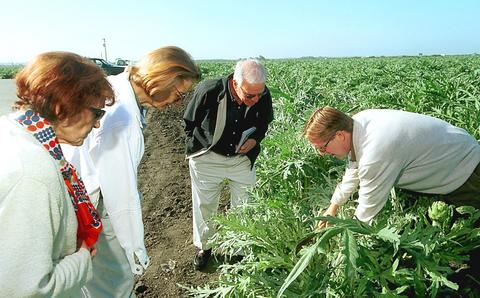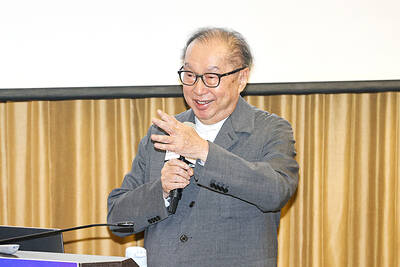Some tourists flock to California to see Hearst Castle, Sausalito, Big Sur and the Golden Gate Bridge. Then there are those who come for the breathtaking views of artichokes.
"I want to talk to you about artichokes," said Evan Oakes, founder of Ag Venture Tours, possibly the country's first company specializing in agricultural bus tours for tourists. "In Egyptian tombs, in Syria and Babylon, they were talking about artichokes."
While artichoke tourism may never rival Disneyland, Oakes, a 41-year-old agricultural research scientist, may represent the Next Big-to-Medium-Size Thing. His bus tour, a sort of 4H for Dummies, is part of a growing national trend toward agricultural tourism. It is a day-long, fact-filled 97km or so gambol through "the nation's salad bowl" -- the Salinas Valley -- the fertile fog-layered land made famous by John Steinbeck. Here, about 50 percent to 75 percent of the country's vegetables are grown, ruled by "the King," as Oakes calls iceberg lettuce.

PHOTO: NY TIMES
"Romaine lettuce is the hottest thing, because everyone is eating Caesar salad now," Oakes observed from behind the wheel before launching into a discourse on seed pelletization, an industrial process that coats seeds to make them more uniform and easier to plant by machine.
While Oakes' tour is offbeat, even for California, it is a tiny but potentially fertile seed in the flourishing movement of agricultural tourism. In states ranging from Vermont to Wisconsin, farm tourism, including "agri-tainment" like U-Pick-'Em Christmas tree lots and Victorian high teas amid hay bales, is on the rise. Spotted in Brainerd, Minnesota: a beef and pork tasting room).
In California, one of 20 states actively promoting agricultural tourism, direct marketing -- including hay rides, farm stands, income from farmers markets, and bed-and-breakfasts on farms -- now accounts for US$75 million a year, a small but increasingly significant part of the state's US$20 billion agricultural industry, said an agricultural economist.
In Vermont, tourism-related agriculture, including sleigh rides, maple sugar visits and sheep wool spinning, represents US$10 million in income for 3,000 small farms.
The interest in agricultural tourism also represents the convergence of several major cultural trends.
"There is a growing concern about where food comes from," said Kent Gustafson, an extension educator in tourism at the University of Minnesota. "And families with young kids are looking for real, authentic experiences beyond Six Flags."
Oakes "is on to something," said Jolly of the University of California at Davis.
"Agriculture is basically cultivated nature," he said, "and this is part of nature tourism. Just as people love to go to national parks and visit forests, they are fascinated with learning how agriculture -- which is well-managed nature -- works. It's part of a healing process."
While not overtly about healing, Oakes' tour does include a picnic at a winery. En route, he addresses many profound changes in the American landscape, like tallying farm-worker productivity with computers and suburban sprawl. As the van sped past a billboard for a new stucco housing development in Salinas, for example, Oakes confided that "seven years ago we used to do lettuce experiments here."
Sprawl is considered "the most threatening problem we face," said Ken Lewis, the owner of the 800-acre Gabilan View Farms outside Salinas. It is more dangerous than even two-spotted mites in a strawberry field, which can be controlled, he explained to the enthralled group, by releasing reddish-orange predator mites -- 30,000 per hectre.
To Lewis and other farmers, visits by Oakes' van are an opportunity for some public relations. "You hear so much about agriculture raping our resources and polluting our streams," he said. "It's not all like that. In every industry, there are always rogues like Enron. But most of us are true husbanders of the soil."
Farmers learn from tourists, too. After making numerous references to what "the housewife" finds appealing about strawberries, Lewis was confronted by Frances Shaffi, a real estate developer from Monterey. "I'm going to gag," she said, barely able to contain herself. "The correct term is consumers, not housewives."
Oakes, who wears an enamel artichoke pin on his left lapel, specializes in viticulture, or wine grapes. He subsidizes his agricultural tours with trips to more mainstream destinations like Hearst Castle and Salinas Valley wineries. A former assistant farm advisor with the Monterey County Agricultural Center in Salinas, he now consults with the University of California. Five years ago, he realized that preaching to the unconverted might be more satisfying than "standing out in the middle of fields taking soil samples and counting aphid colonies on lettuce plants."
Agricultural tourism, he notes, is much more highly developed in Europe, especially in Italy, where rural tourism is seen as a way of maintaining the heritage of villages and revitalizing their economy.
Whether people will come to share his passion for the life cycle of broccoli is an open question. "People don't know where their food comes from," he said. "Here, they see it."
Meanwhile, the living embodiment of everything you always wanted to know about farm scenery but were afraid to ask rolls on, cartons of strawberries teetering on the dashboard.
"Is that mustard?" asked Shaffi, eyeing a fleeting field of yellow flowers.
"Weeds," Oakes replied.

BYPASSING CHINA TARIFFS: In the first five months of this year, Foxconn sent US$4.4bn of iPhones to the US from India, compared with US$3.7bn in the whole of last year Nearly all the iPhones exported by Foxconn Technology Group (富士康科技集團) from India went to the US between March and last month, customs data showed, far above last year’s average of 50 percent and a clear sign of Apple Inc’s efforts to bypass high US tariffs imposed on China. The numbers, being reported by Reuters for the first time, show that Apple has realigned its India exports to almost exclusively serve the US market, when previously the devices were more widely distributed to nations including the Netherlands and the Czech Republic. During March to last month, Foxconn, known as Hon Hai Precision Industry

Taiwan Semiconductor Manufacturing Co (TSMC, 台積電) and the University of Tokyo (UTokyo) yesterday announced the launch of the TSMC-UTokyo Lab to promote advanced semiconductor research, education and talent development. The lab is TSMC’s first laboratory collaboration with a university outside Taiwan, the company said in a statement. The lab would leverage “the extensive knowledge, experience, and creativity” of both institutions, the company said. It is located in the Asano Section of UTokyo’s Hongo, Tokyo, campus and would be managed by UTokyo faculty, guided by directors from UTokyo and TSMC, the company said. TSMC began working with UTokyo in 2019, resulting in 21 research projects,

Ashton Hall’s morning routine involves dunking his head in iced Saratoga Spring Water. For the company that sells the bottled water — Hall’s brand of choice for drinking, brushing his teeth and submerging himself — that is fantastic news. “We’re so thankful to this incredible fitness influencer called Ashton Hall,” Saratoga owner Primo Brands Corp’s CEO Robbert Rietbroek said on an earnings call after Hall’s morning routine video went viral. “He really helped put our brand on the map.” Primo Brands, which was not affiliated with Hall when he made his video, is among the increasing number of companies benefiting from influencer

Quanta Computer Inc (廣達) chairman Barry Lam (林百里) yesterday expressed a downbeat view about the prospects of humanoid robots, given high manufacturing costs and a lack of target customers. Despite rising demand and high expectations for humanoid robots, high research-and-development costs and uncertain profitability remain major concerns, Lam told reporters following the company’s annual shareholders’ meeting in Taoyuan. “Since it seems a bit unworthy to use such high-cost robots to do household chores, I believe robots designed for specific purposes would be more valuable and present a better business opportunity,” Lam said Instead of investing in humanoid robots, Quanta has opted to invest